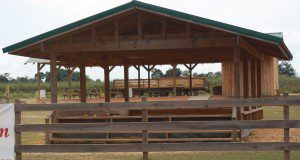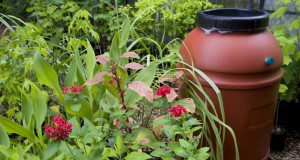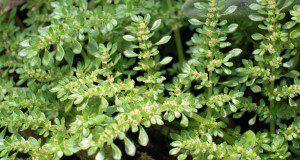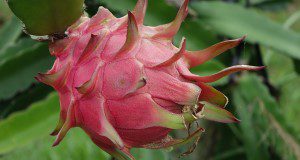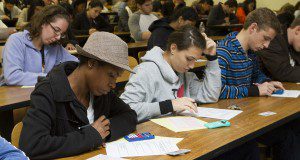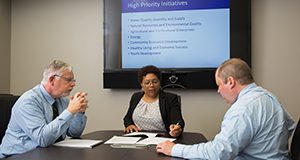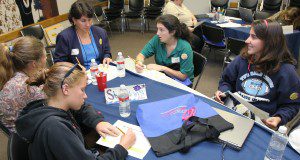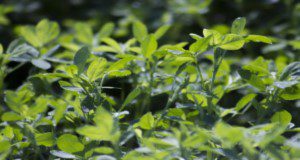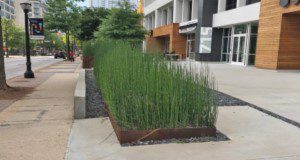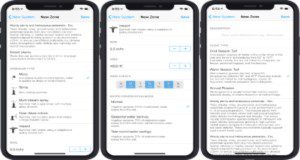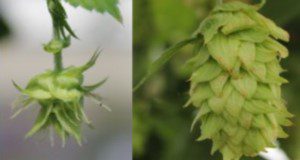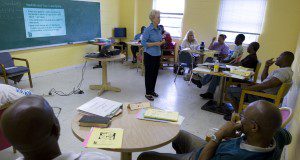Begonias are known by their bright, full flowers and also their leaves, which vary to showcase patterns, designs or color. They are often used as hanging baskets, flowerpots, and garden beds, as well as in the landscape. This new 5-page publication of the UF/IFAS Environmental Horticulture Department is intended for Florida gardeners and horticulturalists hoping to learn more about the different classifications of begonias as well as those interested in learning more about this potential landscape or houseplant. Written by Julian Ginori, Heqiang Huo, and Caroline R. Warwick.
https://edis.ifas.ufl.edu/ep581
Author: Paul Roberts
Fibra alimentaria y enfermedades crónicas
La fibra alimentaria tiene muchos efectos positivos en la salud. Esta publicación describe las relaciones entre la fibra alimentaria y la prevención y el tratamiento de enfermedades crónicas.
This new 2-page publication of the UF/IFAS Food Science and Human Nutrition Department is a Spanish translation of FSHN18-11/FS314, Dietary Fiber and Chronic Disease. Written by Wendy Dahl and translated by Daniela Rivero Mendoza.
https://edis.ifas.ufl.edu/fs322
Florida Agritourism Building and Fire Codes
Agritourism marries Florida’s two largest industries, tourism and agriculture, to provide an on-farm recreational experience for consumers. Although Florida trails many other states in the number of agritourism operations, the number of Florida farms offering recreational experiences more than doubled from 2007 to 2012. This new 4-page document describes building codes relevant to Florida agritourism operations. Written by Mary Beth Henry and Kathryn A. Stofer, and published by the UF/IFAS Department of Agricultural Education and Communication.
https://edis.ifas.ufl.edu/wc349
Floridians' Engagement in Landscape Best Practices to Protect Water Resources: Information from a 2018 Survey
Extension programs are most effective when informed by a deep understanding of the target audience. To guide programs in Florida’s managed landscapes, especially pertaining to water quality and conservation, faculty from the UF/IFAS Center for Landscape Conservation and Ecology conduct an annual statewide survey. The survey gathers data that includes common landscape elements, neighborhood characteristics, engagement in irrigation and fertilizer best practices, and learning preferences. This new 5-page publication of the UF/IFAS Department of Agricultural Education and Communication presents highlights from the 2018 statewide survey with recommendations for how to use the information. Written by Laura A. Warner, Esen Momol, Claire Lewis, Tom Wichman, Wendy Wilber, and A. J. Reisinger.
https://edis.ifas.ufl.edu/wc345
Use of Glyphosate and Herbicide Alternatives for Weed Control in Florida Landscape Planting Beds
This new 10-page article is written for landscape professionals and those maintaining landscape areas to guide them in selecting alternatives to glyphosate (the active ingredient in RoundUp®) for postemergence weed control in Florida. Information is also included on preemergence herbicides and integrated weed management (use of chemical and non-chemical controls), which should be the basis of a weed management program. Written by Chris Marble, Joe Neal, and Andy Senesac, and published by the UF/IFAS Environmental Horticulture Department.
https://edis.ifas.ufl.edu/ep580
Stem and Fruit Canker of Dragon Fruit in South Florida
Dragon fruit, also known as pitahaya, pitaya, and strawberry pear, is a group of vine-like, climbing cacti. In south Florida, production of dragon fruit has been steadily increasing since the 2000s, and growers in Florida consider dragon fruit as a potential alternative fruit crop to avocado and citrus, two economically important fruit crops largely impacted by laurel wilt and huanglongbing, respectively. This new 4-page article focuses on the symptomology and epidemiology of stem and fruit canker, a prevailing disease on dragon fruit. Suggested management strategies for the disease are also discussed based on recent studies conducted in south Florida. Written by Cheng-Fang Hong, Shouan Zhang, Romina Gazis, Jonathan H. Crane, and Jeff Wasielewski, and published by the UF/IFAS Plant Pathology Department.
https://edis.ifas.ufl.edu/pp355
Applying Culturally Relevant Teaching to Workshops: The Checklist
As the diversity of Extension clientele continues to grow, Extension educators must consider new ways of supporting this population. In this new 2-page article, a follow-up to EDIS article AEC678, Culturally Responsive Teaching: A Framework for Educating Diverse Audience, the authors provide a checklist to serve as a guiding tool when planning workshops and to ensure that participants feel connected to, engaged with, and understood while working toward achieving workshop educational goals. Written by Cecilia E. Suarez, John M. Diaz, and Laura E. Valencia, and published by the UF/IFAS Department of Agricultural Education and Communication.
https://edis.ifas.ufl.edu/wc351
Bringing Home the Bacon: Infusing Evaluation Best Practices into Grant Proposals
Proposals possessing sound and well-funded evaluation plans are normally stronger and have greater chances of being funded. This new 4-page publication of the UF/IFAS Department of Agricultural Education and Communication shares information the authors learned during a series of meetings with federal agency program officers and evaluators about best practices for grant proposals. The practices encompass two broad categories: incorporating evaluation expertise into the project team and building a sound project rationale and evaluation plan. By adopting these practices, you will enhance the quality of your proposals; you will most likely increase the amount of extramural funding that is secured; and you will elevate the visibility and impact of programs within your organization. Written by Glenn Israel, Jaclyn D. Kropp, David C. Diehl, Conner Mullally, and Sebastian Galindo.
https://edis.ifas.ufl.edu/wc350
Hop Yard Establishment and Trellis Construction in Florida
Hops (Humulus lupulus L.) are an essential ingredient in brewing, adding bitterness and flavor to beer. Driven by the recent craft beer movement, hop production is expanding into nontraditional hop-producing states. In Florida, while commercial hop production is almost nonexistent, the number of craft breweries in Florida increased from 45 in 2011 to 285 in 2018, and the economic impact of Florida’s craft beer industry exceeds $3 billion. This new 7-page article, written by Shinsuke Agehara, Aleyda Acosta-Rangel, Zhanao Deng, Jack Rechcigl, and Simon Bollin and published by the UF/IFAS Horticultural Sciences Department, provides guidelines and considerations for building a hop yard in Florida, using the UF/IFAS Gulf Coast Research and Education Center’s research hop yard as a model.
https://edis.ifas.ufl.edu/hs1354
Exemplary Youth Leadership Series: Inspire a Shared Vision
This publication series is designed to outline strategies and experiences to expose youth to and engage them with leadership concepts. In this series, activities have been developed to introduce youth to Kouzes and Posner’s five practices of exemplary leaders. This new 2-page article allows students to engage with the second practice: inspiring a shared vision. Leaders shape the trajectory of their organization. The two outlined activities help students illustrate the idea of creating a unique vision and recruiting others to follow that vision. Written by Megan Stein and published by the UF/IFAS Department of Agricultural Education and Communication.
https://edis.ifas.ufl.edu/wc348
Condensed Tannins in Forage Legumes
The use of tannin-containing forages has received attention from researchers around the globe because of potential benefits of condensed tannins to livestock health and nutrition as well as possibilities to reduce methane emission. This new 4-page publication of the UF/IFAS Agronomy Department targets two audiences: Extension faculty who need information on potential benefits and negative effects of condensed tannins to livestock production, and producers who intend to feed tannin-containing forages in their operation. Written by Flavia van Cleef and Jose Dubeux.
https://edis.ifas.ufl.edu/ag440
Considerations for Selection and Use of Ornamental Grasses
Ornamental grasses create interest and excitement in the landscape with their unique characteristics. The availability of a large number of species and cultivars makes these plants very versatile, with many potential uses in the landscape. This publication outlines many of the considerations for the proper selection and use of ornamental grasses. The information and tables should assist the first-time gardener as well as the experienced landscaper in the selection and use of ornamental grasses in Florida. This 9-page major revision was written by Mack Thetford and Mary Salinas and published by the UF/IFAS Environmental Horticulture Department.
https://edis.ifas.ufl.edu/ep233
Simple Imaging Techniques for Plant Growth Assessment
Quantification of plant phenotypic traits, such as height, width, stem diameter, and leaf area, is often performed manually in the field; however, these measurements can be performed more quickly and precisely through simple imaging techniques using an image processing program. This new 5-page publication of the UF/IFAS Horticultural Sciences Department, written by Shinsuke Agehara, describes simple imaging techniques for plant growth assessment using the public domain program ImageJ.
https://edis.ifas.ufl.edu/hs1353
Choosing the Right Blackberry Cultivar in Subtropical Florida
Blackberry (Rubus spp.) is a deciduous berry crop and the fourth most economically important berry crop in the United States. Driven by the growing demand for blackberries, production recently expanded to the southeastern United States. In Florida, however, commercial blackberry production is limited primarily to small commercial U-pick operations. The main challenges include insufficient chill hours and poor fruit quality associated with the subtropical climate. This new 6-page article, a publication of the UF/IFAS Horticultural Sciences Department, will discuss important cultivar selection criteria and recommended blackberry cultivars in subtropical Florida. Written by Shinsuke Agehara, Syuan-You Lin, and Zhanao Deng.
https://edis.ifas.ufl.edu/hs1352
Florida Citrus Rootstock Selection Guide, 4th Edition
This updated 4th edition of the Florida Citrus Rootstock Selection Guide (FLCRSG) is a revision of the 2016 publication. The guide is a convenient, easy-to-use reference to 21 characteristics of 49 rootstocks. Of those, 12 are time-honored commercial rootstocks (highlighted in blue), which are the most reliably characterized. The next 13 rootstocks are minor commercial ones (highlighted in green) that are less frequently used today in Florida but may have been prominent at one time. The third group consists of the most recently released 24 rootstocks (highlighted in yellow) for which there is limited commercial experience. The new addition includes three new USDA rootstocks and updates information on a few traits. Written by William S. Castle, Kim D. Bowman, Jude W. Grosser, Rhuanito Soranz Ferrarezi, Stephen H. Futch, and Steve Rogers, and published by the UF/IFAS Horticultural Sciences Department.
https://edis.ifas.ufl.edu/hs1260
Smartirrigation Apps: Urban Turf
As freshwater resources become increasingly scarce, efficient irrigation scheduling methods that allow efficient irrigation water uses are required. Migliaccio et al. (2016) have developed an app called Smartirrigation Turf, an easy-to-use mobile tool that delivers information to improve irrigation scheduling for urban turf. The app was only available for Florida and Georgia, but recently, we have made improvements to the app and made it available to any location throughout the contiguous United States. The 7-page major revision, written by Haimanote K. Bayabil, K. W. Migliaccio, J. H. Debastiani Andreis, C. Fraisse, K. T. Morgan, and G. Vellidis, and published by the UF/IFAS Department of Agricultural and Biological Engineering, describes the changes made on the recently released Smartirrigation Turf app.
https://edis.ifas.ufl.edu/ae499
Citrus Soil pH Testing Procedures
Maintaining the correct soil pH is essential to ensure optimal plant growth and crop yield. This new two-page document is an instructional sheet for citrus soil pH testing, written by Kelly Morgan and published by the UF/IFAS Department of Soil and Water Sciences.
https://edis.ifas.ufl.edu/ss665
Harvest Techniques for Hops (Humulus lupulus)
Hops (Humulus lupulus) are perennial plants commonly harvested for their mature strobiles, also referred to as cones, which are primarily dried and used as a bittering agent and preservative in beer production. The two primary factors of harvest timing and harvest method can have large impacts on the quality and economics of the finished product. The decision of when and how to harvest is important and should rely upon growing-region-specific environmental conditions, physical observations of the cones, and the wants and needs of the individual producer. This new 4-page publication of the UF/IFAS Environmental Horticulture Department describes the primary methods used in hop harvesting, including field, indoor, and machine harvesting. Written by Sean Michael Campbell and Brian J. Pearson.
https://edis.ifas.ufl.edu/ep578
Citrus Soil pH Management
Management of both soil pH and nutrients is required to maintain soil fertility levels and ensure economic agricultural production. Maintaining soil in the 6.0-6.5 pH range is best for most crops including citrus. This new two-page publication of the UF/IFAS Department of Soil and Water Sciences, written by Kelly Morgan, explains the effects of soil pH on citrus as well as options for management.
https://edis.ifas.ufl.edu/ss666
Conducting the Needs Assessment #2: Using Needs Assessments in Extension Programming
This second publication in the Conducting the Needs Assessment series provides Extension educators and other service providers with a foundational underpinning of how the needs assessment fits within the program planning process. Both formal and nonformal educators seeking to develop and deliver an educational program must first be informed of what their audience lacks in order to develop the right curriculum or training, and therefore conducting a needs assessment is a priority in the program development process. This new publication of the UF/IFAS Department of Agricultural Education and Communication was written by Matthew Benge and Laura Warner.
https://edis.ifas.ufl.edu/wc347


